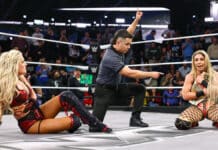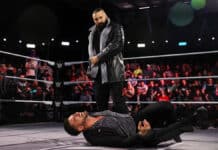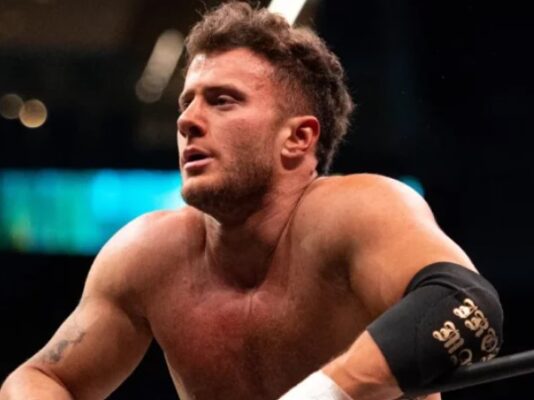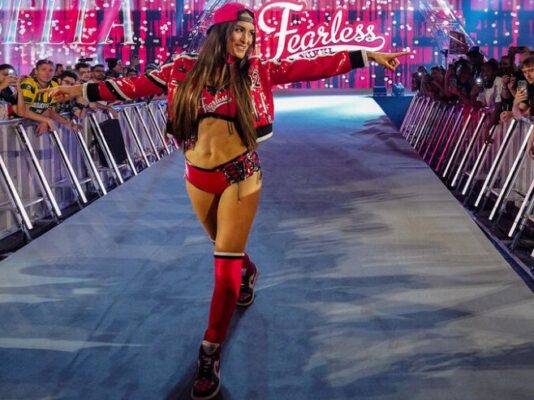
Gas was an average of $1.23 a gallon, Alanis Morissette had the top-selling album of the year, and the medium household income was around $35,000 in the United States. VHS tapes were the media standard, dial-up internet on America Online that tied up your phone line was in its most primitive stages, and Will Smith’s Independence Day was the big draw at the box office.
The year was 1996, and the professional wrestling business was in flux, as shifting dynamics, particularly with WCW’s relatively new executive producer, Eric Bischoff investing money to secure talent from the WWF, pushed the sport forward that had stalled immensely through the down period of the early-90s.
Just as things were changing with narratives bubbling to the surface of the industry that would create an edgier presentation in the years that followed, another career was starting from scratch.
Cody Hawk was barely in his 20s when he decided to jump into professional wrestling. He made a two-hour round trip to learn under the legendary Les Thatcher in Cincinnati, Ohio four times a week just for the opportunity to learn the ropes. This was at the tail end of the period of the business where pro wrestling schools didn’t exist simply to churn out as many students as possible as long as their check cleared for tuition the way that so many places do today. Instead, the goal of training academies during that era was to get the limited amount of students that were granted admission into the programs the ability to become legitimate money-drawing stars in the future to keep the overall industry healthy.
“When I broke in, wrestling was still fairly hard to get in to, there wasn’t a school on every corner. You had to send VHS tapes all over the country and hope someone called. I’ve carried many practices forward, I still have my old school mind even though I realize the business has evolved. I have also evolved trying my best to blend both worlds,” Cody explained.
The ability to be given the stamp of approval to officially start a career from a trainer was almost as difficult as getting accepted into the wrestling school in the first place.
“I started reffing matches in 1996. I trained as a wrestler, but my trainer wouldn’t allow us to wrestle until he thought we were good enough,” Hawk recalled.
Finally, in August of 1998 after Cody had learned not only the in-ring maneuvers, how to land on the canvas as safely as possible, but also how a match truly comes together from his time as a referee from the previous few years, it was time for his official debut as a professional wrestler. True to his humble beginnings as a student in the sport, he’s debut was also an example of old school pro wrestling. When he nervously laced up his boots that night at the Hamilton National Guard Armory in Hamilton, Ohio with about 200 fans in attendance, he didn’t know it at the time, but the first step that he took into a ring as an official pro would also be the first step on a path that would define the rest of his life.
“I wrestled one of the assistant coaches that worked as a heel named GQ Masters. Obviously, I was a nervous wreck, but I trained daily with my opponent so I knew he had me if I failed,” Hawk said.
Cody Hawk was a natural in the squared circle with a level of poise well beyond his experience as a performer. He had all the fundamental basis covered for what a top prospect in the sport should have as they look to move up the ladder within the industry. It didn’t take long for that to happen as just a year after he started his career at the armory with barely 200 people in attendance, he found himself at The Joe Louis Arena in Detroit in front of nearly 14,000 fans when he worked a six man tag on the Shotgun Saturday Night portion of a WWF Raw taping. The year after that, Hawk was featured on television again, this time for World Championship Wrestling in another six man tag for their Worldwide show.
Training under Les Thatcher opened the door for Hawk to wrestle for The Heartland Wrestling Association, one of the early WWF developmental territories, long before a state-of-the-art Performance Center existed. Very similar to how he broke into the sport, his formative years were just as old school, a weekly territory that had to sell tickets and get fans into the seats to maintain itself. The WWF working agreement had some of their most valued prospects and top independent talent working on the cards on a nightly basis to attempt to make it to the next level. Within just a few years in the business, Cody Hawk was thrown into the deep water, but made a name for himself as a youngster that could go step for step with some of the most highly-recruited talent within the program.
He shared the ring with numerous names that not only went on to make a name for themselves, but allowed Hawk to become a more well-rounded performer in the process. Lance Cade, Umaga. Rosey, BJ Whitmer, the Haas brothers, Nigel McGuinness, and The Blade were just some of the stellar talent that he competed against during his first handful of years in the industry.
He became such a part of the fabric of the HWA that when he wasn’t in the ring on a live event, he was still in the squared circle, assisting with teaching sequences to classes of new trainees. In fact, what started as just a way to help out the next group of aspiring hopefuls eventually opened the door for what arguably defines Hawk’s career perhaps more than anything else, his ability as a prolific trainer.
“I never set out to be a trainer, I just happened to be one of the better students and some times when Les was busy, he’d put me or one of the other guys in charge of class. We’d run his drills and check each other. Over time that became more and more until I was offered the spot of training the unsigned talent in HWA when it was under developmental contract with WWE. That never stopped and I’m still training aspiring athletes today,” he explained.
Hawk cites his time as a trainer as one of the highlights of a career that has spanned nearly thirty years.
“I don’t care about being famous, I care about helping the pro wrestling dreamers achieve their goals, I care about good old fashioned storytelling. I care about professional wrestling,” he added.
Among the countless grapplers that he helped literally learn the ropes, there are a few of them that are a reminder of his contributions to the industry on a weekly basis on television. A few of his prized students include the recently retired, TNA’s Sami Callihan, WWE’s LA Knight, and Jon Moxley on AEW Dynamite.
“Everyone knew Jon was going to make money. They all persevered and they’re all killing it today. I couldn’t be more proud of them, or any and all of my students that followed their dreams. They chased their goals and got however far up the proverbial wrestling ladder,” Hawk remarked.
Hawk was presented the Cauliflower Alley Trainer’s Award by Jon Moxley in 2019 at the group’s annual convention.
In the late-2000s, Hawk actually owned HWA for a period of time before the changing pro wrestling market led him to pursue other avenues, opting to open his own training center in the years that followed. However, it was in more recent years that a message on social media led to his next full-time gig in the sports entertainment industry, a unique opportunity to say the least, but one that has allowed him to continue to shape a direction within the business as he has done in some form or fashion virtually his entire career.
The owner of the Micro Wrestling Federation, a league of micro grapplers that became wildly popular over the years through their extensive touring schedule, Jack Darrell Hillegass reached out to Cody about assisting with talent. What started as a two-day spot and then commuting to the Mirco home base in Pigeon Forge, Tennessee for six weeks become a job that keeps Hawk on the road almost 52 weeks a year. Hillegass paid well and covered Hawk’s lodging during that initial stint so Cody knew this was a natural next step in his career to contribute to the industry.
“I was asked if I wanted a full time gig training out of the Microtorium, I was cool with that. However, I knew there was a driver spot open too so I volunteered to drive because it would pay me even more. Soon after, my boss paid for me to leave Ohio for good and move to Tennessee, it was best life change ever. As for 300 days on the road, it’s tough, but I really do enjoy it. I was never meant to stay stationary,” Cody commented.
No job is too big or too small for Cody Hawk, as he’s quite literally grown up in the business. He knows the goal is to make a living and sometimes those duties include something as mundane as ring crew or as integral as teaching the next generation. But, his involvement with Micro Wrestling isn’t merely about dollars and cents.
“My goal here is to break the stereotype of little people wrestling. These ladies and gentlemen can flat out get it. They need to be seen as professional wrestlers and not just little people. They need to be seen on a major stage,” he said.
At 52, Cody Hawk stays as busy as ever, working full-time with the Micro Wrestling Federation, still training and still producing shows with as much enthusiasm now as he did in his youth back in the HWA days. Hawk never needed to see his name in lights, but rather simply aspired to be a part of the industry as much as possible, and after nearly three decades, he continues to be in the business full-time, still meeting that goal that he set when he was barely out of his teenage years. As he gets close to celebrating thirty years in the business in a few months, Cody Hawk can reflect on a career that ranks him as one of the most influence performers during that same time span in the entire industry.
“I want wrestlers and fans to know that I always gave everything I had when I was in the ring. I want anyone that ever trained under me to know that I gave them my all whether they gave me their all or not,” Hawk concluded.
For more information about Cody Hawk, you can go to https://www.facebook.com/Wrestler.CodyHawk
What do you think? Share your thoughts, opinions, feedback, and anything else that was raised on Twitter @PWMania and Facebook.com/PWMania.
Until next week
-Jim LaMotta
Email [email protected] | You can follow me on Instagram, Facebook, & Threads @jimlamotta89












